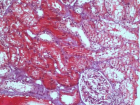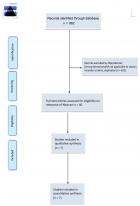Abstract
Research Article
Association between clinical forms of Leprosy and contacts with the vaccination state with BCG in five endemic municipalities in the Brazilian Amazon
Maria do Perpétuo Socorro Amador Silvestre*, Maxwell Furtado de Lima and E Luana Nepomuceno Gondim Costa Lima
Published: 19 July, 2022 | Volume 5 - Issue 1 | Pages: 001-004
Introduction: The World Health Organization (WHO) strategy for leprosy control from 2021 to 2030 focuses on interrupting transmission, reducing autochthonous cases to zero, and using a safe and effective vaccine and chemoprophylaxis. In 2020, 127,396 new cases were registered in the world, 19,195 new cases in the Americas, and, of these, 17,979 cases in Brazil, about 93.66% of the total in the Americas. Brazil is classified as a country with a high burden of the disease, occupying the 2nd place in the world, behind only India (WHO, 2020). Análise do período de 2010-2015 em publicação recente9, apresenta as seguintes cidades no estado do Pará nas quais se observou maiores taxas de incidência (detecção): Marituba, Belém, Marabá, Parauapebas e Altamira [9].
Material and method: This is an analytical retrospective study carried out in a database - Epi-Info resulting from records of Surveillance and Seroprevalence actions in five endemic municipalities for leprosy located in the Southeast and West of Pará. The following variables were analyzed: age, sex, Clinical Classification, vaccination status with BCG, and the result of the search for IgM antibodies against PGL-1 of Mycobacterium leprae by the “In house” ELISA technique.
Results: We evaluated 1551 records examined in the laboratory from 2014 to 2016, which were classified into 123 Multibacillary -MB patients (123/1551 = 7.93%); 71 Paucibacillary-PB patients (71/1551 = 4.57%); 451 Intradomicilliary Consanguineous Contacts - CCOSI (451/1551 = 29.07%) and 906 Non Consanguineous Contacts - CNCOS (906/1551 = 58.41%). 57 MB patients (13.47%), 13 PB patients (3.07%), 133 CCOSI (31.44%) and 220 CNCOS (52.00%) were positive for PGL-1. The correlation of the Classification with the vaccination status showed 57 MB patients without any BCG (57/125 = 45.6%) and only 3 patients with two doses of BCG (3/125 = 2.4%); 17 PB patients without any dose of BCG (17/69 = 24.63%); 80 CCOSI without any BCG (80/455 = 17.58%) and 171 CNCOS (171/906 = 18.87%). The odds ratio (OR) in the analysis between unvaccinated MB patients compared to CCOSI was statistically significant (OR = 14.25; p ˂ 0.0001). The study shows the importance of using the BCG vaccine in healthy contacts of patients with leprosy, as it shows the probability of unvaccinated individuals being 14.25 times more likely to become ill with Multibacillary forms compared to CCOSI. In addition, the BCG vaccine has been in use for 80 years and is the only vaccine that we can use in leprosy control programs.
Conclusion: Although the leprosy epidemiological data analyzed recently (2010 - 2015) show a downward trend in the main indicators in Pará, such as the detection of new cases and prevalence, the endemic municipalities are still classified as hyperendemic for the population under 15 years of age and This proves that Surveillance is essential, as well as BCG vaccination according to the Ministry of Health Standards.
Read Full Article HTML DOI: 10.29328/journal.ijcmbt.1001024 Cite this Article Read Full Article PDF
References
- World Health Organization – WHO. Towards zero leprosies. Global leprosy (Hansen's disease) strategy 2021 – 2030. ISBM – 978-92-9022-850-9
- Andrade RO. The persistence of leprosy. Epidemiological Bulletin. Edition 283, 2019.
- Bricks LF. Vacina BCG: via percutânea ou intradérmica? [Percutaneous or intradermal BCG vaccine?]. J Pediatr (Rio J). 2004 Mar-Apr;80(2):93-8. Portuguese. PMID: 15079177.
- World Health Organization – WHO. Weekly Epidemiological Record. 2004; 79: 25–40. http/www.who.int/wer
- Cunha MD, Santos RS, Matos HJ, Oliveira MLW. Epidemiological aspects of leprosy. Cad. Public Health, Rio de Janeiro. June 2012; 28(6): 1143–1155.
- Barreto ML, Pereira SM, Ferreira AA. BCG vaccine: efficacy and indications for vaccination and revaccination. J Pediatr (Rio J). 2006 Jul;82(3 Suppl):S45-54. doi: 10.2223/JPED.1499. PMID: 16826312.
- Lombardi C, Pedrazzani ES, Pedrazzani JC, Ferreira Filho P, Zicker F. Eficacia protectora del BCG contra la lepra en São Paulo, Brasil [The protective efficacy of BCG against leprosy in São Paulo, Brazil]. Bol Oficina Sanit Panam. 1995 Nov;119(5):415-21. Spanish. PMID: 8540997.
- Silvestre MPSA, Lima LNGC, Araújo AB, Quaresma JAS. Polymorphism of the human NRAMP1 gene, anti-PGL-I antibody levels and leprosy susceptibility in endemic areas of Pará State, Brazil. Rev Pan-Amaz Saude. 2012 Dec;3(4):17-26.
- Pires CAA, Chaves EC, Salmen CF, Balieiro ABR, santos MBL, Filho GGA. Analysis of the clinical-epidemiological profile of leprosy in Pará and evaluation of health indicators. Reas/EJCH. 2019; 27.
- Ministry of Health. National Secretariat for Special Programs. National Division of Sanitary Dermatology. Secretary of State for Public Health – SESPA. Leprosy epidemiological indicators report, 2016.
- Neto BF, Sílvia ER, Geha YF, Santos JNG, Mota JV, Pereira WMN. Leprosy in the state of Pará: spatial and temporal patterns visualized by the analysis of epidemiological indicators from 2004 to 2018. Research Society and development. 2021; 10.
- Ministry of Health. Health Surveillance Department. Special Epidemiological Bulletin, 2021. Publisher MS/CGDI.
- Bührer SS, Smits HL, Gussenhoven GC, van Ingen CW, Klatser PR. A simple dipstick assay for the detection of antibodies to phenolic glycolipid-I of Mycobacterium leprae. Am J Trop Med Hyg. 1998 Feb;58(2):133-6. doi: 10.4269/ajtmh.1998.58.133. PMID: 9502593.
- Foss NT. Immunological aspects of leprosy. Medicine, Ribeirão Preto, 1997; 30: 335-339.
- Goulart IM, Penna GO, Cunha G. Imunopatologia da hanseníase: a complexidade dos mecanismos da resposta imune do hospedeiro ao Mycobacterium leprae [Immunopathology of leprosy: the complexity of the mechanisms of host immune response to Mycobacterium leprae]. Rev Soc Bras Med Trop. 2002 Jul-Aug;35(4):365-75. Portuguese. doi: 10.1590/s0037-86822002000400014. PMID: 12170333.
- Carvalho FM. Mycobacterium leprae-specific in vitro cellular immune response from contacts of patients with multibacillary leprosy at baseline and during treatment of the index case. [Thesis (Master's degree]. Oswaldo Cruz Institute. Postgraduate in Cellular and Molecular Biology. Rio de Janeiro, 2013. 142.
Figures:
Similar Articles
-
Oral Candida colonization in HIV-infected patients: Species and antifungal susceptibility in Tripoli/LibyaEllabib M*,Mohamed H,Mokthar E,Ellabib M,El Magrahi H,Eshwika A. Oral Candida colonization in HIV-infected patients: Species and antifungal susceptibility in Tripoli/Libya . . 2018 doi: 10.29328/journal.ijcmbt.1001001; 1: 001-008
-
Evaluation of novel culture media prepared from plant substrates for isolation and identification of Cryptococcus Neoformans Species ComplexEllabib M*,Krema ZA,Mokthar ES,El Magrahi HS,Eshwika A,Cogliati M. Evaluation of novel culture media prepared from plant substrates for isolation and identification of Cryptococcus Neoformans Species Complex. . 2018 doi: 10.29328/journal.ijcmbt.1001002; 1: 009-013
-
Trypanosoma dionisii as an experimental model to study anti-Trypanosoma cruzi drugs: A comparative analysis with benznidazole, posaconazole and amiodaroneDe Souza W*,Barrias ES,Borges TR. Trypanosoma dionisii as an experimental model to study anti-Trypanosoma cruzi drugs: A comparative analysis with benznidazole, posaconazole and amiodarone. . 2018 doi: 10.29328/journal.ijcmbt.1001003; 1: 014-023
-
A Review on filaricidal activity of phytochemical extracts against filariasis and the Parasites Genomic DiversityAM Gumel*,MM Dogara. A Review on filaricidal activity of phytochemical extracts against filariasis and the Parasites Genomic Diversity. . 2018 doi: 10.29328/journal.ijcmbt.1001004; 1: 024-032
-
Host biomarkers for early diagnosis of infectious diseases: A comprehensive reviewArindam Chakraborty*,Singh Monica. Host biomarkers for early diagnosis of infectious diseases: A comprehensive review. . 2019 doi: 10.29328/journal.ijcmbt.1001005; 2: 001-007
-
Virulence Genes in Pseudomonas Aeruginosa Strains Isolated at Suez Canal University Hospitals with Respect to the Site of Infection and Antimicrobial ResistanceNermine Elmaraghy*,Said Abbadi,Gehan Elhadidi,Asmaa Hashem,Asmaa Yousef. Virulence Genes in Pseudomonas Aeruginosa Strains Isolated at Suez Canal University Hospitals with Respect to the Site of Infection and Antimicrobial Resistance. . 2019 doi: 10.29328/journal.ijcmbt.1001006; 2: 008-019
-
Knowledge, perception and practices of Suez Canal University students regarding Hepatitis C Virus infection risk and means of preventionNermine Elmaraghy*,Hesham El-Sayed,Sohair Mehanna,Adel Hassan,Mahmoud Sheded,Maha Abdel-Fattah,Samar Elfiky,Nehal Lotfy,Zeinab Khadr. Knowledge, perception and practices of Suez Canal University students regarding Hepatitis C Virus infection risk and means of prevention. . 2019 doi: 10.29328/journal.ijcmbt.1001007; 2: 020-027
-
in silico discovery of potential inhibitors against Dipeptidyl Peptidase-4: A major biological target of Type-2 diabetes mellitusNouman Rasool*,Andleeb Subhani,Waqar Hussain,Nadia Arif. in silico discovery of potential inhibitors against Dipeptidyl Peptidase-4: A major biological target of Type-2 diabetes mellitus. . 2020 doi: 10.29328/journal.ijcmbt.1001008; 3: 001-010
-
Production and evaluation of enzyme-modified lighvan cheese using different levels of commercial enzymesMohammad B Habibi Najafi*,Mohammad Amin Miri. Production and evaluation of enzyme-modified lighvan cheese using different levels of commercial enzymes. . 2020 doi: 10.29328/journal.ijcmbt.1001009; 3: 011-016
-
Development of ELISA based detection system against C. botulinum type BArti Sharma*,S Ponmariappan. Development of ELISA based detection system against C. botulinum type B. . 2020 doi: 10.29328/journal.ijcmbt.1001010; 3: 017-020
Recently Viewed
-
Drinking-water Quality Assessment in Selective Schools from the Mount LebanonWalaa Diab, Mona Farhat, Marwa Rammal, Chaden Moussa Haidar*, Ali Yaacoub, Alaa Hamzeh. Drinking-water Quality Assessment in Selective Schools from the Mount Lebanon. Ann Civil Environ Eng. 2024: doi: 10.29328/journal.acee.1001061; 8: 018-024
-
Rapid Microbial Growth in Reusable Drinking Water BottlesQishan Liu*,Hongjun Liu. Rapid Microbial Growth in Reusable Drinking Water Bottles. Ann Civil Environ Eng. 2017: doi: 10.29328/journal.acee.1001007; 1: 055-062
-
Beneficial effects of a ketogenic diet in a woman with Charcot-Marie-Tooth diseaseElvira Rostanzo,Anna Maria Aloisi*. Beneficial effects of a ketogenic diet in a woman with Charcot-Marie-Tooth disease. Arch Food Nutr Sci. 2022: doi: 10.29328/journal.afns.1001040; 6: 068-072
-
Isolation and Influence of Carbon Source on the Production of Extracellular Polymeric Substance by Bacteria for the Bioremediation of Heavy Metals in Santo Amaro CityLeila Thaise Santana de Oliveira Santos*, Kayque Frota Sampaio, Elisa Esposito, Elinalva Maciel Paulo, Aristóteles Góes-Neto, Amanda da Silva Souza, Taise Bomfim de Jesus. Isolation and Influence of Carbon Source on the Production of Extracellular Polymeric Substance by Bacteria for the Bioremediation of Heavy Metals in Santo Amaro City. Ann Civil Environ Eng. 2024: doi: 10.29328/journal.acee.1001060; 8: 012-017
-
Management and use of Ash in Britain from the Prehistoric to the Present: Some implications for its PreservationJim Pratt*. Management and use of Ash in Britain from the Prehistoric to the Present: Some implications for its Preservation. Ann Civil Environ Eng. 2024: doi: 10.29328/journal.acee.1001059; 8: 001-011
Most Viewed
-
Evaluation of Biostimulants Based on Recovered Protein Hydrolysates from Animal By-products as Plant Growth EnhancersH Pérez-Aguilar*, M Lacruz-Asaro, F Arán-Ais. Evaluation of Biostimulants Based on Recovered Protein Hydrolysates from Animal By-products as Plant Growth Enhancers. J Plant Sci Phytopathol. 2023 doi: 10.29328/journal.jpsp.1001104; 7: 042-047
-
Sinonasal Myxoma Extending into the Orbit in a 4-Year Old: A Case PresentationJulian A Purrinos*, Ramzi Younis. Sinonasal Myxoma Extending into the Orbit in a 4-Year Old: A Case Presentation. Arch Case Rep. 2024 doi: 10.29328/journal.acr.1001099; 8: 075-077
-
Feasibility study of magnetic sensing for detecting single-neuron action potentialsDenis Tonini,Kai Wu,Renata Saha,Jian-Ping Wang*. Feasibility study of magnetic sensing for detecting single-neuron action potentials. Ann Biomed Sci Eng. 2022 doi: 10.29328/journal.abse.1001018; 6: 019-029
-
Pediatric Dysgerminoma: Unveiling a Rare Ovarian TumorFaten Limaiem*, Khalil Saffar, Ahmed Halouani. Pediatric Dysgerminoma: Unveiling a Rare Ovarian Tumor. Arch Case Rep. 2024 doi: 10.29328/journal.acr.1001087; 8: 010-013
-
Physical activity can change the physiological and psychological circumstances during COVID-19 pandemic: A narrative reviewKhashayar Maroufi*. Physical activity can change the physiological and psychological circumstances during COVID-19 pandemic: A narrative review. J Sports Med Ther. 2021 doi: 10.29328/journal.jsmt.1001051; 6: 001-007

HSPI: We're glad you're here. Please click "create a new Query" if you are a new visitor to our website and need further information from us.
If you are already a member of our network and need to keep track of any developments regarding a question you have already submitted, click "take me to my Query."

















































































































































